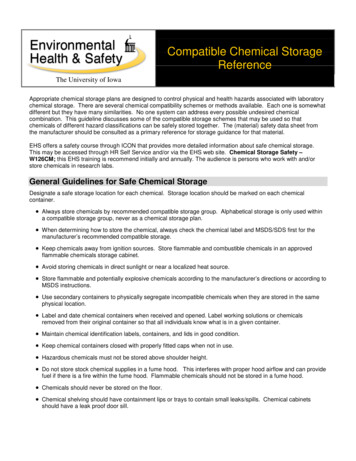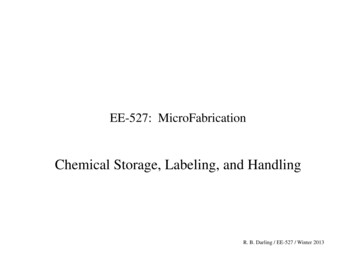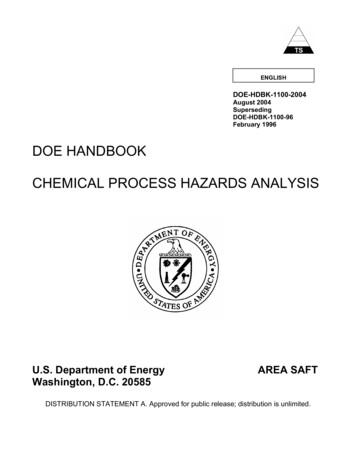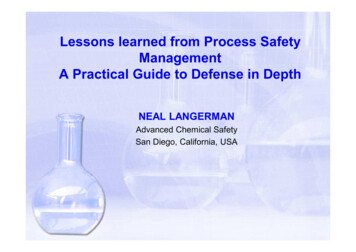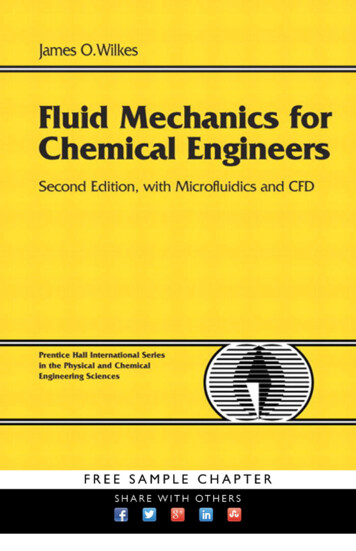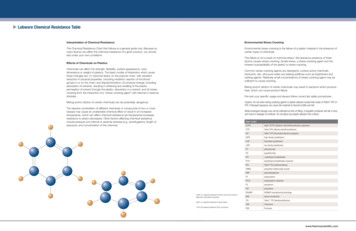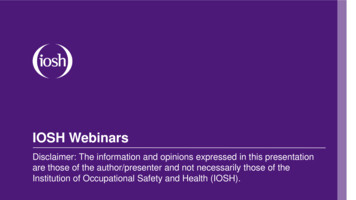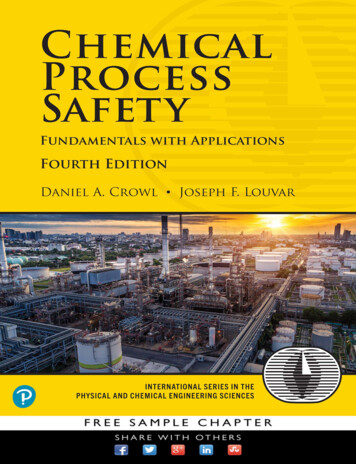
Transcription
Chemical Process SafetyFourth Edition
This page intentionally left blank
Chemical Process SafetyFundamentals with ApplicationsFourth EditionDaniel A. CrowlJoseph F. LouvarBoston Columbus New York San Francisco Amsterdam Cape TownDubai London Madrid Milan Munich Paris Montreal Toronto Delhi Mexico CitySão Paulo Sydney Hong Kong Seoul Singapore Taipei Tokyo
Many of the designations used by manufacturers and sellers to distinguish their products are claimed astrademarks. Where those designations appear in this book, and the publisher was aware of a trademark claim,the designations have been printed with initial capital letters or in all capitals.The authors and publisher have taken care in the preparation of this book, but make no expressed or impliedwarranty of any kind and assume no responsibility for errors or omissions. No liability is assumed for incidentalor consequential damages in connection with or arising out of the use of the information or programs containedherein.For information about buying this title in bulk quantities, or for special sales opportunities (which may includeelectronic versions; custom cover designs; and content particular to your business, training goals, marketingfocus, or branding interests), please contact our corporate sales department at corpsales@pearsoned.com or (800)382-3419.For government sales inquiries, please contact governmentsales@pearsoned.com.For questions about sales outside the U.S., please contact intlcs@pearson.com.Visit us on the Web: informit.comLibrary of Congress Control Number: 2019930097Copyright 2019 Pearson Education, Inc.Cover image: Travel Mania/ShutterstockAll rights reserved. This publication is protected by copyright, and permission must be obtained from thepublisher prior to any prohibited reproduction, storage in a retrieval system, or transmission in any form or byany means, electronic, mechanical, photocopying, recording, or likewise. For information regarding permissions,request forms and the appropriate contacts within the Pearson Education Global Rights & PermissionsDepartment, please visit www.pearsoned.com/permissions/.ISBN-13: 978-0-13-485777-0ISBN-10: 0-13-485777-1119
ContentsPreface xvAbout the Authors xviiiNomenclature xx1Introduction 11-11-21-31-41-51-61-71-81-9Engineering Ethics 6Myths about Process Safety 7Myth 1: Process safety costs a lot of money and has a negative impact on thecompany’s bottom line. 7Myth 2: Process safety is the same as personal or even laboratory safety. 8Myth 3: Process safety is no more than following rules and regulations. 8Myth 4: Process safety is a soft science—no more than hard hats or safetyshoes—not engineering science. 9Myth 5: Process safety applies only to the petrochemical industry. 9Myth 6: Industry should train graduates in process safety; this topic shouldnot be a part of the undergraduate engineering curriculum. 10Myth 7: Process safety does not include product safety. 10Safety Culture 10Individual Risk, Societal Risk, and Risk Populations 13Voluntary and Involuntary Risk 14Safety Metrics 15Accident and Loss Statistics 17Risk Perception 27Risk Tolerance/Acceptance and Risk Matrix 27v
vi -32-42-52-62-72-83Codes, Standards, and Regulations 31Safeguards 33The CCPS 20 Elements of Risk-Based Process Safety 36Inherently Safer Design 42The Worst Chemical Plant Tragedy: Bhopal, India, 1984 46Overview of Chemical Process Safety 49Suggested Reading 49Problems 5055How Toxicants Enter the Body 56Gastrointestinal Tract 57Skin 58Respiratory System 58How Toxicants Are Eliminated from the Body 59Effects of Toxicants on the Body 60Toxicological Studies 61Dose versus Response 62Dose and Response Using Probit Equation 68Relative Toxicity 74Threshold Limit Values 75Online Resources 76Suggested Reading 77Problems 77Industrial Hygiene 793-13-23-33-43-5Anticipating and Identifying Hazardous Workplace Exposures 80Globally Harmonized System 83Globally Harmonized System for Safety Data Sheets 83Globally Harmonized System for Labeling 87Evaluate the Magnitude of Exposures and Responses 89Evaluating Exposures to Volatile Toxicants by Monitoring 90Evaluating Worker Exposures to Dusts 93Evaluating Worker Exposures to Noise 94Evaluating Worker Exposures to Thermal Radiation 96Estimating Worker Exposures to Toxic Vapors 97Estimating the Vaporization Rate of a Liquid 100Estimating Worker Exposures during Vessel Filling Operations 103Develop and Evaluate Control Techniques to Prevent Exposures 106Respirators 108Ventilation 109National Fire Protection Association Diamond 115Online Resources 116Suggested Reading 117Problems 117
Contents 4viiSource Models1194-14-24-34-4Introduction to Source Models 121Flow of Liquid through a Hole 123Flow of Liquid through a Hole in a Tank 126Flow of Liquids through Pipes 1302-K Method 1344-5 Flow of Gases or Vapors through Holes 1404-6 Flow of Gases or Vapors through Pipes 145Adiabatic Flows 146Isothermal Flows 1524-7 Flashing Liquids 1624-8 Liquid Pool Evaporation or Boiling 1684-9 Realistic and Worst-Case Releases 1694-10 Conservative Analysis 169Suggested Reading 172Problems 1735Hazardous Material Dispersion 1775-15-25-35-45-5Parameters Affecting Dispersion 178Neutrally Buoyant Dispersion Models 183Pasquill–Gifford Model 184Case 1: Puff with Instantaneous Point Source at Ground Level, CoordinatesFixed at Release Point, Constant Wind Only in x Direction with ConstantVelocity u 189Case 2: Plume with Continuous Steady-State Source at Ground Level andWind Moving in x Direction at Constant Velocity u 190Case 3: Plume with Continuous Steady-State Source at Height Hr aboveGround Level and Wind Moving in x Direction at Constant Velocity u 190Case 4: Puff with Instantaneous Point Source at Height Hr above GroundLevel and a Coordinate System on the Ground That Moves with thePuff 191Case 5: Puff with Instantaneous Point Source at Height Hr above GroundLevel and a Coordinate System Fixed on the Ground at the ReleasePoint 192Isopleths 192Effect of Release Momentum and Buoyancy 193Worst-Case Dispersion Conditions 194Limitations to Pasquill–Gifford Dispersion Modeling 195Dense Gas Dispersion 197Toxic Effect Criteria 198Emergency Response Planning Guidelines 199Immediately Dangerous to Life and Health 199Emergency Exposure Guidance Levels and Short-Term Public EmergencyGuidance Levels 202Acute Exposure Guideline Levels 204
viii Contents5-66Threshold Limit Values 207Permissible Exposure Limits 207Toxic Endpoints 207Release Prevention and Mitigation 209Suggested Reading 212Problems 212Fires and Explosions 2196-16-26-36-4The Fire Triangle 220Distinction between Fires and Explosions 221Definitions 221Flammability Characteristics of Liquids and Vapors 224Liquids 224Gas and Vapor Mixtures 227Flammability Limit Dependence on Temperature 229Flammability Limit Dependence on Pressure 229Estimating Flammability Limits 230Limiting Oxygen Concentration (LOC) and Inerting 234Flammability Diagram 236Autoignition 244Auto-Oxidation 245Adiabatic Compression 2456-5 Flammability Characteristics of Dusts 2476-6 Sprays and Mists 2486-7 Ignition Energy 2486-8 Ignition Sources 2506-9 Experimental Characterization of Gas/Vapor and Dust Explosions 251Gases/Vapors 251Dusts 255Application of Flammability Data of Gases/Vapors and Dusts 2586-10 Explosions 258Detonation and Deflagration 259Confined Explosions 261Blast Damage Resulting from Overpressure 261TNT Equivalency 265TNO Multi-Energy Method 266Energy of Chemical Explosions 270Energy of Mechanical Explosions 272Missile Damage 274Blast Damage to People 274Vapor Cloud Explosions (VCE) 276Boiling-Liquid Expanding-Vapor Explosions 277Suggested Reading 278Problems 278
Contents 7ixConcepts to Prevent Fires and Explosions 2837-17-27-37-47-57-67-7Inerting 284Vacuum Purging 285Pressure Purging 288Combined Pressure–Vacuum Purging 289Vacuum and Pressure Purging with Impure Nitrogen 291Sweep-Through Purging 292Siphon Purging 293Using the Flammability Diagram to Avoid Flammable Atmospheres 293Static Electricity 299Fundamentals of Static Charge 299Charge Accumulation 300Electrostatic Discharges 300Energy from Electrostatic Discharges 303Energy of Electrostatic Ignition Sources 304Streaming Current 304Electrostatic Voltage Drops 307Energy of Charged Capacitors 308Capacitance of a Body 312Controlling Static Electricity 315General Design Methods to Prevent Electrostatic Ignitions 316Relaxation 317Bonding and Grounding 317Dip Pipes 320Increasing Conductivity with Additives 321Handling Solids without Flammable Vapors 321Handling Solids with Flammable Vapors 321Explosion-Proof Equipment and Instruments 323Explosion-Proof Housings 323Area and Material Classification 324Design of an XP Rated Area 325Ventilation 325Open-Air Plants 325Plants Inside Buildings 326Sprinkler Systems 329Industry’s Fire and Explosion Protection Strategy 332Practices 332Passive and Active Systems 333Plant Fire Protection Infrastructure 333Documentation of Fire and Explosion Protection Strategy 334Suggested Reading 334Problems 334
x Contents8Chemical Reactivity 3378-18-28-38-49Introduction to Reliefs 3799-19-29-39-49-59-69-710Background Understanding 338Commitment, Awareness, and Identification of Reactive ChemicalHazards 340Characterization of Reactive Chemical Hazards Using Calorimeters 346Introduction to Reactive Hazards Calorimetry 347Theoretical Analysis of Calorimeter Data 353Estimation of Parameters from Calorimeter Data 364Adjusting the Data for the Heat Capacity of the Sample Vessel 369Heat of Reaction Data from Calorimeter Data 370Using Pressure Data from the Calorimeter 370Application of Calorimeter Data 371Controlling Reactive Hazards 372Suggested Reading 374Problems 374Relief Concepts 380Definitions 381Code Requirements 383Relief System Design 386Fire Protection 391Relief Types and Characteristics 391Spring-Operated Reliefs 392Rupture Discs 394Buckling or Rupture Pin Reliefs 395Pilot-Operated Reliefs 396Advantages and Disadvantages of Various Reliefs 400Relief Installation Practices 400Relief Effluent Handling 403Horizontal Knockout Drum 405Flares 405Scrubbers 406Condensers 406Suggested Reading 406Problems 406Relief Sizing 41110-1 Set Pressure and Accumulation Limitsfor Reliefs 41310-2 Relief Sizing for Liquid Service 41510-3 Relief Sizing for Vapor and Gas Service 422Subcritical Vapor/Gas Flow 424Steam Flow Relief Sizing 424
Contents xi10-410-510-610-711Rupture Disc Sizing 424Pilot-Operated Relief Sizing 425Buckling Pin Relief Sizing 425Two-Phase Flow during Runaway Reaction Relief 428Deflagration Venting for Dust and Vapor Explosions 434Vents for Gases/Vapors and Mists 436Vents for Dusts and Hybrid Mixtures 439Venting for Fires External to the Process 440Reliefs for Thermal Expansion of Process Fluids 444Suggested Reading 447Problems 449Hazards Identification and Evaluation 45311-1 Introduction to Hazard Identification/Evaluation and Risk Analysis 45511-2 Non-Scenario-Based Hazard Identification/Evaluation Methods 463Checklist Analysis 463Safety Reviews 466Inherent Safety Reviews 467Preliminary Hazard Analysis 468Relative Ranking 46911-3 Scenario-Based Hazard Identification/Evaluation Methods 471Hazard and Operability Studies 471Failure Modes and Effects Analysis 479What-If Analysis 482What-If/Checklist Analysis 48211-4 Documentation and Actions Required for Hazard Identificaton andEvaluation 483Suggested Reading 483Problems 48312Risk Analysis and Assessment48712-1 Review of Probability Theory 487Interactions between Process Units 489Revealed and Unrevealed Failures 496Probability of Coincidence 499Redundancy 500Common-Cause Failures 50112-2 Event Trees 50112-3 Fault Trees 506Determining the Minimal Cut Sets 509Quantitative Calculations Using the Fault Tree 512Advantages and Disadvantages of Fault Trees 512
xii Contents12-4 Bow-Tie Diagrams 51312-5 Quantitative Risk Analysis 51412-6 Layer of Protection Analysis 515Estimating the LOPA Consequence 518Estimating the LOPA Frequency 51812-7 Risk Assessment 526Consequence versus Frequency Plot 526Individual Risk: Risk Contours 526Societal Risk: F-N Plots 527Suggested Reading 530Problems 53013Safety Strategies, Procedures, and Designs53313-1 Process Safety Strategies 533Process Safety Hierarchy 533Human Factors 533Managing Safety 534Incident Investigations 535Root Cause Analysis 53613-2 Safe Operating Procedures 53713-3 Safe Work Practices 538Hot Work 539Energy Isolation (Lock-Out/Tag-Out—LOTO; Lock, Tag, Try) 539Confined-Space Entry (Vessel Entry) 54013-4 Designs for Process Safety 541Inherently Safer Designs 541Controls: Emergency Isolation Valves 541Controls: Double Block and Bleed 541Controls: Safeguards and Redundancy 542Controls: Explosion Suppression 543Flame Arrestors 544Containment 544Materials of Construction 545Process Vessels 546Miscellaneous Designs for Preventing Fires and Explosions 54713-5 Designs for Runaway Reactions 54713-6 Designs and Practices for the Safe Handling of Dusts 548Preventing Dust Explosions 549Suggested Reading 549Problems 55014Case Histories and Lessons Learned 55114-1 Process Safety Culture 552Case History: Explosions at a Refinery Due to Inadequate Process SafetyCulture 552
Contents 214-1314-1414-15Compliance with Standards 553Case History: Dust Explosions at a Pharmaceutical Plant Due toInadequate Training on the Use of Standards 553Process Safety Competency 554Case History: An Explosion of a Blender Due to Inadequate Knowledgeof Chemical Process Safety 554Workplace Involvement 555Case History: A Fatality in a Ribbon Blender Due to an InadequateLock-Out/Tag-Out Permit System 555Stakeholder Outreach 556Case History: Increased Consequences in an AdjacentCommunity Due to Inadequate Outreach 556Process Knowledge Management 556Case History: A Runaway Reaction and Explosion Due to InadequateProcess Knowledge Management 556Hazard Identification and Risk A
27.10.2017 · 1-15 Overview of Chemical Process Safety 49 Suggested Reading 49 Problems 50 2 Toxicology 55 2-1 How Toxicants Enter the Body 56 Gastrointestinal Tract 57 Skin 58 Respiratory System 58 2-2 How Toxicants Are Eliminated from the Body 59 2-3 Effects of Toxicants on the Body 60 2-4 Toxicological Studies 61 2-5 Dose versus Response 62 2-6 Dose and Response Using Probit

